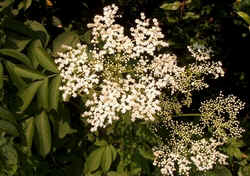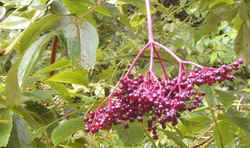 |
 |
Common Name: Elderberry
Scientific Name: Sambucus canadensis
Family: Caprifoliaceae
Woodland Drive
Columbus, North Carolina
Flowers -- June 7, 2002
Fruit -- August 25, 2002
 |
 |
The soft, pithy, branching stems of this native shrub grow 3 - 10 feet tall. The flat inflorescence of small, fragrant, white flowers is often 6 inches or more broad. These shrubs grow in moist rich soil in open pastures, in alluvial woods, and along fencerows and forest margins throughout North Carolina and much of the northeastern United States. The fruit ripens in July or August. May - July [Justice, William S. and Bell, C. Ritchie, Wild Flowers of North Carolina. University of North Carolina Press, Chapel Hill, 1968]
The elderberry shrub, with white flower heads followed by black-purple fruits, is a strong-growing member of the honeysuckle family, usually found in moist soils on the edges of meadows or swamps. It is known by discriminating the people to be wonderful for pie as well as wine. The various medicinal properties are less well known, however. The dried inner bark of the stem has been used for centuries as a dependable active purgative, which should be used cautiously because it is emetic in large doses. The bark of the root is violently purgative and dangerous. Although there are alkaloids and poisons in the leaves, which make them safe only for external use, an ointment made from the leaves is recommended for bruises and sprains. In ancient times, the juice of the leaves was used as an eye-wash. A country woman writes that for headaches her grandmother "warmed the leaves of elderberry and applied them to the forehead." The heat-thickened juice of elderberries forms "an invaluable cordial for coughs and colds," while a draught of hot elder wine before bed is soporific and promotes perspiration, helping to ward off the effects of a chill. It is, however, the flowers of elder which receive the most favorable notice, being the part of the plant which is recognized in the National Formulary. When carefully dried and cleaned of stems, says Youngken "the fresh flowers are employed as a diaphoretic and stimulant and in the preparation of elder flower ointment and water." Elder-flower water, for which there are a number of recipes, was once used as a cosmetic to remove freckles, alleviate sunburn, and relieve itching. One home recipe for elder-flower ointment says to take the flower heads without leaves and rub them into the purest lard until no more blossoms can be pushed in. Place in a clean baking tin, and dry in a moderate oven until the flowers are quite brown. Strain through muslin and store in small jars. Such an ointment will beautify complexions, heal sores, and keep away flies. [Coon, Nelson, Using Plants for Healing, Hearthside Press, Inc., 1963]
January February March April May June July August September October November December
Alphabetical Listings -- A B C D, E F G H I, J, K L M N, O P Q, R S T U, V W X, Y, Z
Family Listings -- A B C D, E F G H I, J, K L M N, O P Q, R S T U, V W X, Y, Z
Genus Listings -- A B C D, E F G H I, J, K L M N, O P Q, R S T U, V W X, Y, Z